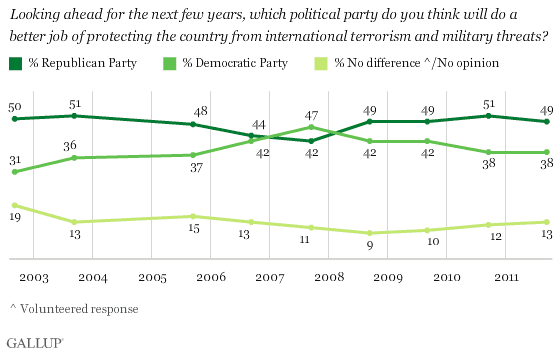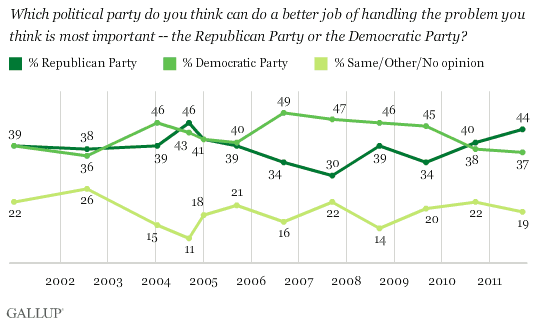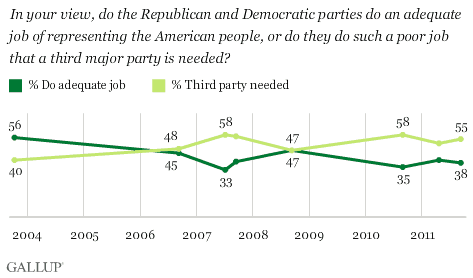This story is part of an ongoing series on Gallup.com on Americans' views on the role and performance of government.
PRINCETON, NJ -- Americans see the Republican Party as better able than the Democratic Party to protect the country from terrorism and military threats, and to keep the country prosperous over the next few years.

These views come as record numbers of Americans are dissatisfied with the way the nation is being governed and express highly negative opinions about a number of other dimensions of the federal government. Next year's elections provide Americans with an opportunity to vent their frustrations in the presidential and the congressional elections. At this point, Republicans, who currently control the House but not the presidency or the Senate, appear to be at least slightly better positioned going into the elections, given Americans' preference for the GOP to handle the nation's domestic and international woes.
Democrats held the advantage over the Republican Party on the "prosperous" dimension from 2003 through 2009, a period that included the majority of George W. Bush's presidency and the first year of Barack Obama's. The advantage switched to the GOP last year and remains so this year, by 48% to 39%.

Americans' current tilt toward the Republican Party as better able to handle terrorist and military threats has generally persisted over the past decade, with the exception of a September 2007 survey in which the Democrats edged out the Republicans.

Republicans on Top as Better Able to Handle Most Important Problem
Americans perceive Republicans as better able than Democrats to handle what they name as the nation's most important problem, giving the GOP the clear advantage on this metric for the first time.
Gallup asks Americans each month to name the most important problem facing the country and occasionally poses a follow-up question asking which party they perceive as better able to handle that problem. The responses to this follow-up question have varied over the past decade, depending partly on what the dominant problem was at the time of the survey.
Democrats held the advantage on this measure in early 2004, 2006, and 2007, for example, when the situation in Iraq was at the top of the "most important problem" list. Democrats continued to edge out the GOP in 2008 and 2009, when the economy became the most important problem. The two parties were close in 2010, with the economy dominating as the top problem. Republicans, however, have moved ahead in this year's September survey, in which Americans name jobs/unemployment as the top problem facing the country.

Majority Favors Third Party
Americans are highly dissatisfied with the way things are going in the nation and have low economic confidence, creating an environment in which a third-party challenger could find significant backing from American voters. Indeed, 55% of Americans say the two major parties do such an inadequate job of representing the American people that a third party is needed.
Americans' current views regarding a third party are similar to what was measured last year and in 2007. However, in other years over the past decade, interest in a third party has been somewhat lower -- particularly in September 2008, in the middle of a spirited presidential election campaign involving Obama and John McCain, the two major-party candidates.

A slight majority of Democrats say a third party is not needed, while Republicans are evenly split on the issue. Independents, representing 44% of the population in this September poll, are, however, very much in favor of a third party -- with 68% saying it is needed.
Americans Doubt Single-Party Control Would Be Better
Several bitter partisan disputes have occurred in Washington this year. These have threatened to disrupt or shut down the federal government, and include the wrangling over the debt ceiling in July, which was solved only at the last minute and with a short-term fix. These partisan disputes highlight the difficulties of governing with a Republican-controlled House and a Democratic-controlled Senate and presidency.
Americans apparently do not, however, believe that having the government under the control of just one party would be better. Twenty-eight percent say same-party control would be better, while just as many say it is better to have divided control of government. Americans are most likely to say it doesn't make any difference either way. Although there has been some fluctuation on this measure over the past 10 years, the 2003 "same party" high point of 35% is not materially higher than what is found today.
![2002-2011 Trend: Do you think is it better for the country -- [ROTATED: to have a president who comes from the same political party that controls Congress, does it make no difference either way, or do you think it is better to have a president from one political party and Congress controlled by another]?](http://content.gallup.com/origin/gallupinc/GallupSpaces/Production/Cms/POLL/5uomkju-iekmytht6wih7g.gif)
Bottom Line
Gallup's special series on Americans' views of government underscores the high level of dissatisfaction many Americans have with the federal government and their representatives in Congress. That in turn leads to the question of what can be done to solve these problems.
Given a choice, Americans at this juncture appear slightly more inclined to believe that the Republican Party is better situated than the Democratic Party to handle the problems facing the nation. That could be because a Democrat is in the White House at a time when Americans are dissatisfied with the state of the nation and the government. Americans also express interest in a third party to challenge the two major parties, although this level of interest is not unusually high. Additionally, there doesn't appear to be strong sentiment that the current divided control in Washington is the major problem with government.
Survey Methods
Results for this Gallup poll are based on telephone interviews conducted Sept. 8-11, 2011, with a random sample of 1,017 adults, aged 18 and older, living in all 50 U.S. states and the District of Columbia.
For results based on the total sample of national adults, one can say with 95% confidence that the maximum margin of sampling error is ±4 percentage points.
Interviews are conducted with respondents on landline telephones and cellular phones, with interviews conducted in Spanish for respondents who are primarily Spanish-speaking. Each sample includes a minimum quota of 400 cell phone respondents and 600 landline respondents per 1,000 national adults, with additional minimum quotas among landline respondents by region. Landline telephone numbers are chosen at random among listed telephone numbers. Cell phone numbers are selected using random-digit-dial methods. Landline respondents are chosen at random within each household on the basis of which member had the most recent birthday.
Samples are weighted by gender, age, race, Hispanic ethnicity, education, region, adults in the household, and phone status (cell phone only/landline only/both, cell phone mostly, and having an unlisted landline number). Demographic weighting targets are based on the March 2010 Current Population Survey figures for the aged 18 and older non-institutionalized population living in U.S. telephone households. All reported margins of sampling error include the computed design effects for weighting and sample design.
In addition to sampling error, question wording and practical difficulties in conducting surveys can introduce error or bias into the findings of public opinion polls.
View methodology, full question results, and trend data.
For more details on Gallup's polling methodology, visit www.gallup.com.
